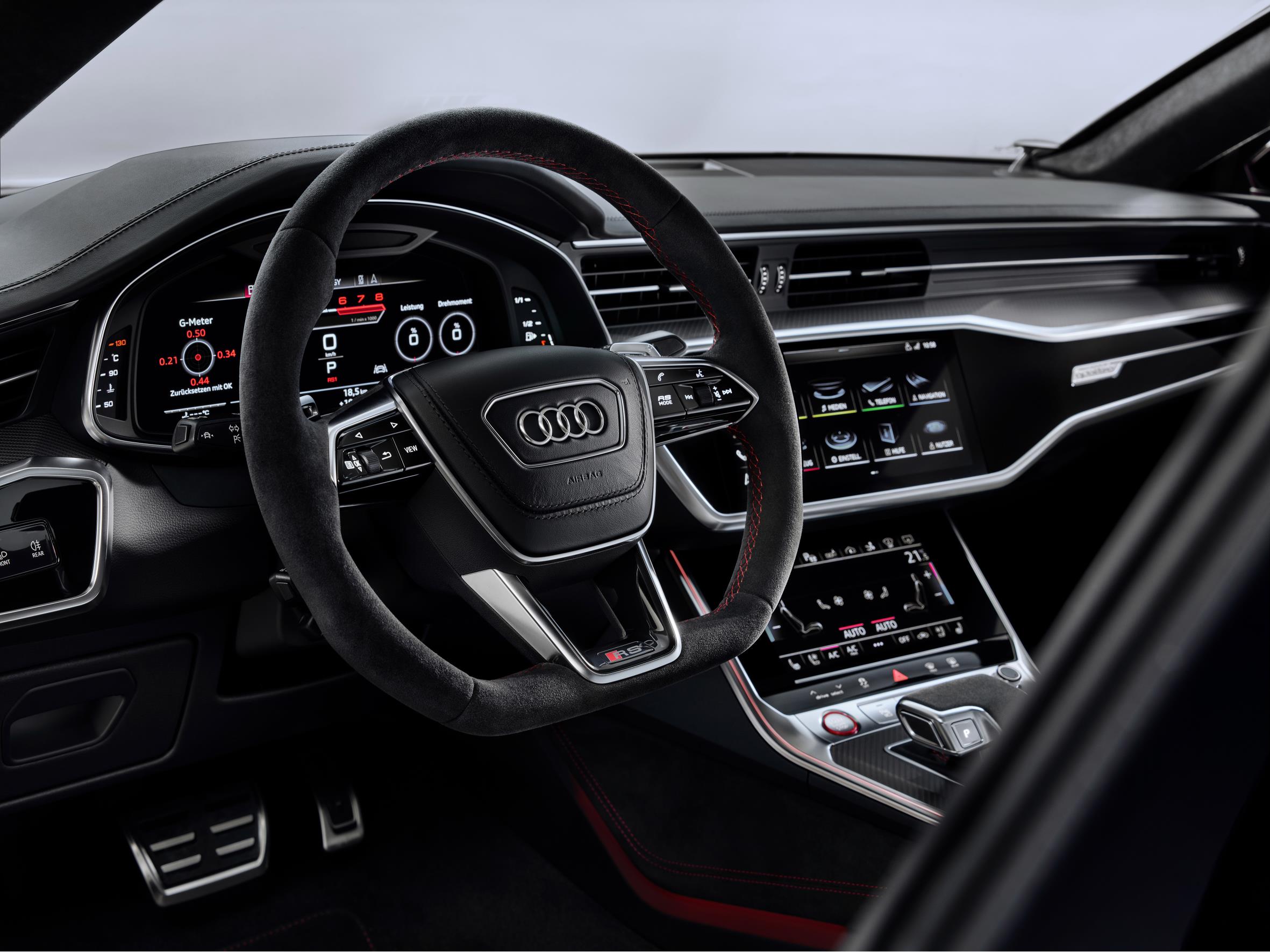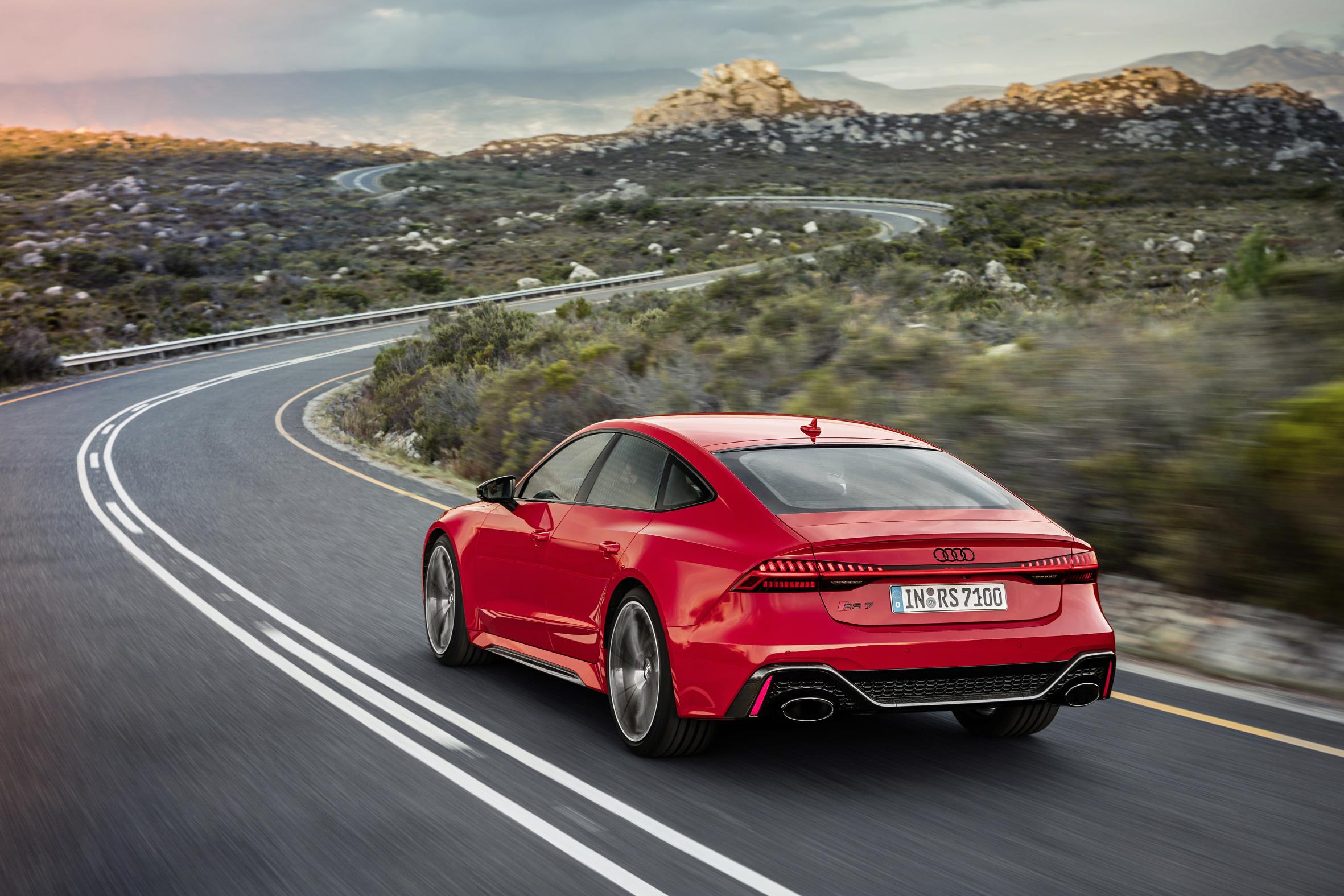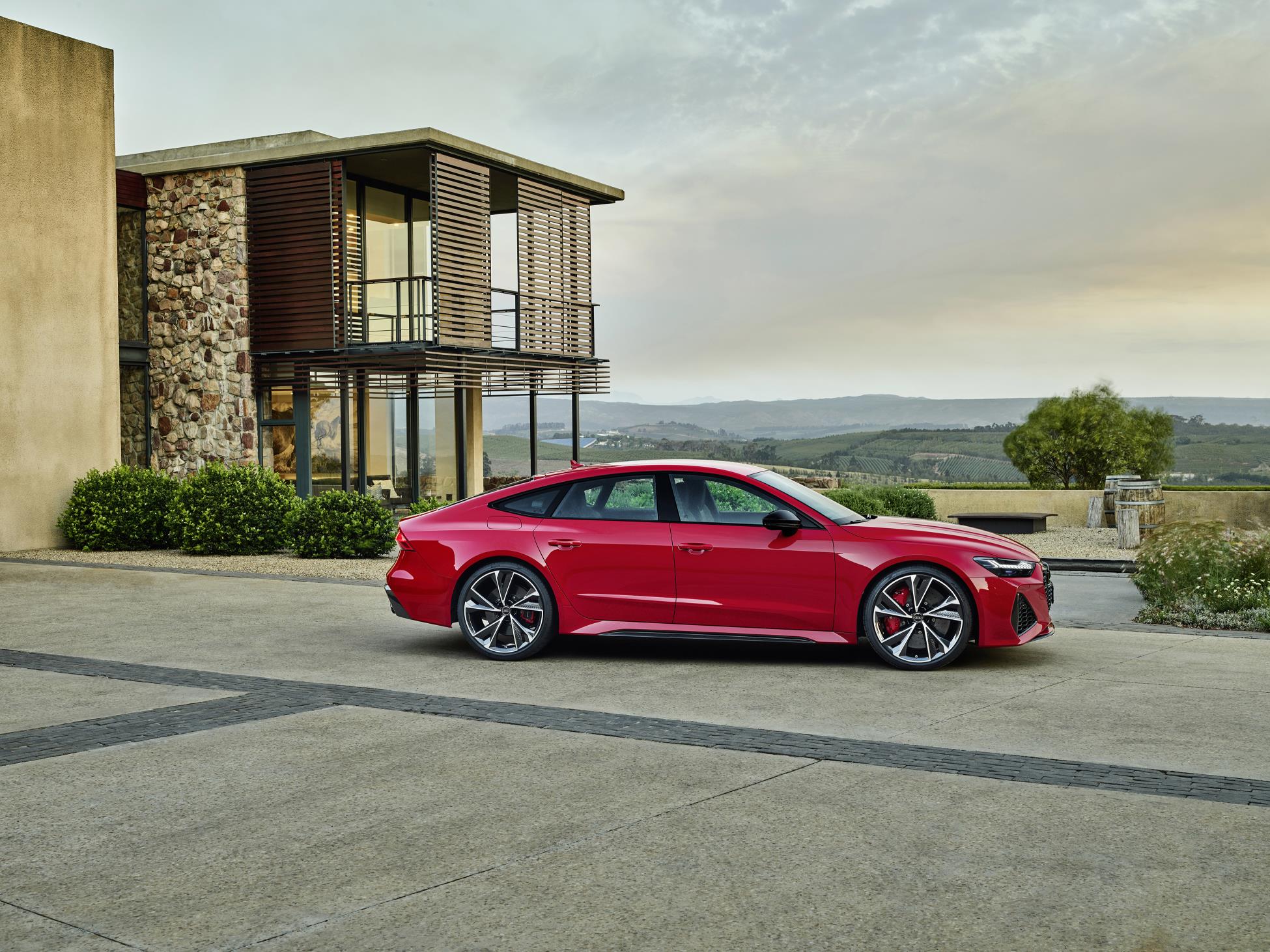
Twin-turbo V8 RS 7 returns with new five-seat configuration and all the benefits of the latest generation A7, including mild hybrid drive
- New wide-bodied high-performance five-seat Sportback available to order in the UK from November – first deliveries in January 2020
- V8 twin turbo: 4.0 TFSI producing 600PS and 800 Nm
- Available in the UK with standard and Vorsprung specification options
Ingolstadt/Frankfurt, September 10, 2019 – The normally urbane Audi A7 Sportback is about to bare fangs again as the successor to the original RS 7 brings 600PS and 800Nm to bear on the 2019 Frankfurt Motor Show. More power meets greater practicality and improved efficiency in the new second generation model, which for the first time houses five seats and a mild hybrid drivetrain within its significantly broadened body. Available in the UK in ‘standard’ and top tier Vorsprung forms, the latest addition to the fast-growing Audi Sport stable is set to reach its first customers here in early 2020.
“The RS 7 Sportback is our interpretation of a five-door high-performance coupé with a grand tourer design,” said Oliver Hoffmann, Managing Director of Audi Sport GmbH. “With refinements to make it even more suitable for everyday use plus its incredible performance, what we have here is an outstanding piece of sports equipment for customers who like their cars to feature stunning design.”
Innovative: the exterior design
Although unmistakably descended from the A7 Sportback, with which it in fact shares only its bonnet, roof, front doors and tailgate, the new RS 7 Sportback looks perpetually ready to wield its sledgehammer performance – its sinewy body virtually hugs the road surface, and its sizeable wheels are shrouded by boldly flared arches that leave no margin for doubt about the mettle of this latest Audi Sport offering.
To accentuate the 1,951-millimetre width even further, the front of the new RS 7 Sportback features a broad, flat Singleframe with no contrasting border. The radiator protective grille with its gloss black RS-specific three-dimensional honeycomb structure and the large front air inlets and vertical fins also contribute to the dramatic stance, as do the horizontal blade marking a distinctive downward edge to the front end and the RS matrix LED laser headlights with their dark bezels and dynamic indicators. Along with the rear LED lights, these ultra-sophisticated units also run through RS-specific ‘animation’ sequences when the vehicle is locked and unlocked.
The side view of the new Audi RS 7 Sportback with its sharply defined lines and curved surfaces calls to mind skin drawn tautly over highly developed muscle. A low shoulder line shifts the visual emphasis downward, while the window line rises towards the rear, giving a sense of dynamism even when the vehicle is stationary. The RS-specific door sills with black inlays accentuate the high-performance Sportback’s distinct impression of forward movement.
The rear end’s curved trailing edge and strip of LED lights linking the main rear lights make it one of the characteristic defining features of the RS 7 Sportback. The RS exhaust system broadcasts a suitably rich and full-bodied V8 soundtrack from two characteristically large, oval tailpipes finished in chrome which sit beneath an RS-specific bumper with a rear diffuser and gloss black detailing. At speeds of 62mph and above a spoiler extends from the tailgate.





Sporty and futuristic: the interior
Much like the exterior design, the architecture inside the new RS 7 Sportback combines taut surfacing with clearly defined contours, and seamlessly integrates the futuristic user interface. The upper MMI touch response display is embedded in the predominantly black architecture in a way that renders it almost impossible to see where the display ends and the surroundings begin. The driver can use the upper RS monitor display to call up an overview of drive system component temperatures, maximum g-forces and information regarding tyre pressures and temperatures.
Special RS displays use the Audi virtual cockpit to provide details of tyre pressure, torque, performance, oil temperature, boost pressure, lap times, acceleration, and g-forces. The shift light display prompts the driver to upshift when the rev limit is reached.
RS sport seats upholstered with perforated Valcona leather featuring a honeycomb pattern and RS embossing are standard, positioning the driver perfectly behind the flat-bottomed, fully perforated RS sport leather steering wheel with new large RS aluminium shift paddles and multifunction buttons, including the RS MODE button, which the driver can use to enable the new Audi drive select RS1 and RS2 modes. This automatically opens the RS-specific displays in the Audi virtual cockpit. The RS and RS 7 logos adorn the steering wheel, seats, and illuminated front door sill trims. Logo projectors on the front and rear doors beam the Audi Sport emblem onto the ground when the doors are open.
For the first time, Audi Sport is offering the five-door RS 7 Sportback with a three-seater rear bench in the interest of maximum versatility. When its split seat backs are folded down up to 1,390 litres of luggage space are made available, and when five adults are on board 535 litres remain at their disposal. The long tailgate opens and closes electrically as standard, with an optional convenience key allowing it to be operated by foot gesture control.
V8 power: the drive system
The 4.0 TFSI in the new Audi RS 7 Sportback produces 600PS and delivers 800 Nm (590 lb-ft) of torque within a broad range from 2,100 to 4,500 rpm. The high-performance Sportback will sprint from 0 to 62mph in only 3.6 seconds and reach V-max at an electronically limited 155mph.
Accompanying the performance is a suitably characterful and full-bore V8 sound which can be modulated via the standard Audi drive select dynamic handling system In the customisable RS1 and RS2 modes, customers can decide for themselves whether they want a sporty or balanced tone.
Thanks to its mild hybrid system (MHEV) with a 48-volt main on-board electrical system, the 4.0 TFSI combines maximum performance with high efficiency. The belt alternator starter can recover up to 12 kW of power and feed it into a lithium-ion battery as electricity. If the driver releases the accelerator at a speed of between 34mph and 99mph, the drive management will select one of two options, either recovering energy or coasting with the engine switched off depending on the driving situation and the settings in Audi drive select. When the driver steps on the accelerator, the belt alternator starter will start the engine again. MHEV technology also allows for start-stop activation at speeds of 13mph and below. As soon as the vehicle in front of the new RS 7 Sportback starts moving, the engine will restart —even if the brakes are applied.
The cylinder on demand (COD) system is another major attribute when it comes to efficiency. In higher gears at low to medium loads and engine speeds, it will deactivate cylinders 2, 3, 5 and 8 by halting injection and ignition and closing the intake and exhaust valves. In four-cylinder mode, the operating points will switch to the active cylinders at higher loads, thereby improving efficiency, while the deactivated cylinders continue to run like gas springs, largely without any losses. When the driver presses the accelerator pedal, they are reactivated immediately. Each switchover takes mere milliseconds and is virtually undetectable by the driver and passengers. The way in which the MHEV components interact improves ride comfort. In conjunction with the COD system, it is possible to reduce fuel consumption by as much as 0.8 litres per 100 kilometres.
The power produced by the 4.0 TFSI is directed by the standard eight-speed tiptronic transmission with optimised shift times and a new launch control function to the quattro permanent all-wheel drive system. Drive forces are distributed to the front and rear axles in a 40:60 ratio via the purely mechanical centre differential. If one wheel slips, more drive torque is automatically transferred to the axle with the better traction. Up to 70 percent can flow to the front wheels and up to 85 percent to the rear.
Five-link front and rear axles handle the lateral and longitudinal forces independently in the new RS 7 Sportback, and are combined with RS-specific adaptive air suspension with controlled damping, automatic levelling and three driving modes. In the normal position, the body of the new RS 7 Sportback sits 20 millimetres lower than the Audi A7 Sportback with standard suspension, and at speeds in excess of 74mph drops by a further 10 millimetres. Wheel-selective torque control supports the advanced suspension, applying the brakes gently to the wheels on the inside of a bend before they have the chance to break traction, and the quattro sport differential – a standard feature of UK RS 7 Sportback models – also enhances the experience, promoting adjustability by shifting torque between the rear wheels as needed during committed cornering. Progressive steering with quick and direct feedback is also standard.
The driver can determine the character of an RS 7 Sportback using the Audi drive select dynamic handling system, which features six profiles: comfort, auto, dynamic, efficiency and the customizable RS-specific RS1 and RS2 modes, which can be enabled directly via an RS MODE button on the steering wheel. Audi drive select influences factors including engine and transmission management, steering assistance, the suspension, dynamic all-wheel steering, the quattro sport differential, the exhaust flaps, and the operating characteristics of the automatic air conditioning system. In RS2 mode, customers can switch the Electronic Stabilisation Control (ESC) to sport mode at the touch of a button.
In standard form the new RS 7 Sportback is fitted as standard with 21-inch cast aluminium wheels with a 10-spoke star design and 275/35 tyres. A 22-inch 5-V-spoke design with 285/30 tyres is reserved for the Vorsprung version. Within them, the powerful RS brake system features internally ventilated and perforated discs measuring 420 millimetres upfront and 370 millimetres at the rear.
A broad palette of colours and materials
The range of colours for the new Audi RS 7 Sportback encompasses thirteen standard exterior paint finishes, including the two RS-specific shades of Nardo grey and Sebring black, crystal effect, as well as five available matt effect paint finishes.






